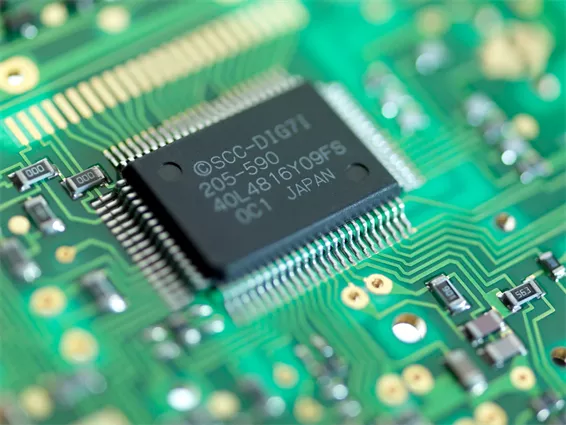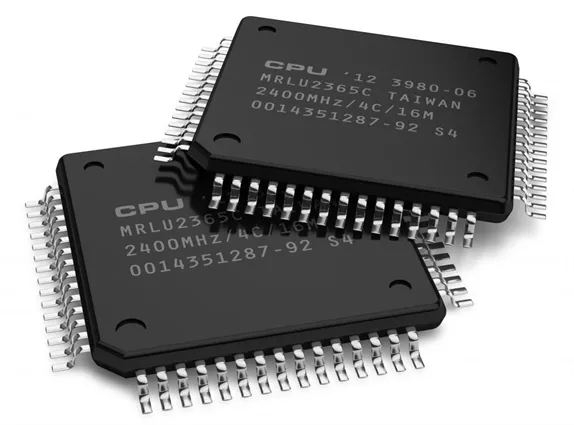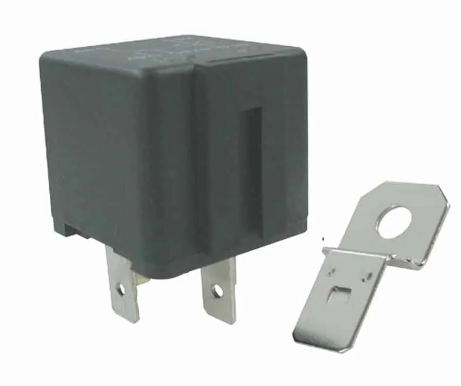In the tech realm, the question often arises, "How is a microprocessor different from an integrated circuit?" This article aims to answer that question in detail.
Defining the Components: Microprocessors and Integrated Circuits

Microprocessors:
A microprocessor is a central processing unit (CPU) designed to process instructions and perform tasks in digital devices such as computers, smartphones, tablets, and embedded systems. It is an integrated circuit that contains the arithmetic logic unit (ALU), control unit, registers, and cache memory. Here are some key points about microprocessors:
-
Functionality: Microprocessors execute instructions, perform arithmetic and logic operations, control input/output operations, and manage data within a computing system.
-
Architecture: Microprocessors are designed with specific architectures, such as the von Neumann architecture or Harvard architecture, which determine their performance and capabilities.
-
Clock Speed: The clock speed of a microprocessor, measured in gigahertz (GHz), indicates how many instructions it can execute per second. Higher clock speeds generally result in faster processing.
-
Cache Memory: Microprocessors have built-in cache memory to store frequently accessed data and instructions, reducing the time required to retrieve information from the system memory.
-
Instructions Sets: Microprocessors are designed to support specific instruction sets (e.g., x86, ARM), which determine the types of operations they can perform.
Integrated Circuits:
Integrated circuits (ICs), also known as microchips or chips, are miniaturized electronic circuits that contain multiple interconnected electronic components, such as transistors, resistors, capacitors, and diodes, fabricated on a single semiconductor substrate. Here are some key points about integrated circuits:
-
Classification: Integrated circuits can be categorized into various types based on their complexity and functionality, such as analog ICs, digital ICs, mixed-signal ICs, and programmable ICs.
-
Fabrication: ICs are fabricated using semiconductor materials, typically silicon, through processes like photolithography and etching. The miniaturization of components on ICs follows Moore's Law, which predicts the doubling of transistors on a chip approximately every two years.
-
Applications: Integrated circuits are used in a wide range of electronic devices, including smartphones, computers, medical devices, automotive systems, IoT devices, and more, due to their compact size and high level of integration.
-
Types of ICs: Integrated circuits include microprocessors, memory chips, operational amplifiers, voltage regulators, FPGA (Field-Programmable Gate Arrays), and many other specialized components.
-
Advantages: Integrated circuits offer advantages such as reduced size, improved reliability, lower power consumption, higher performance, and cost-effectiveness compared to discrete electronic components.
In summary, microprocessors are specialized integrated circuits that function as the brain of a computing system, while integrated circuits encompass a broader range of electronic components fabricated on a single chip to perform specific functions in electronic devices.

Key Differences Between Microprocessors and Integrated Circuits
Microprocessors and integrated circuits are both essential components in modern electronics, but they serve different functions and have distinct characteristics. Here are the key differences between microprocessors and integrated circuits:
Microprocessors:
-
Functionality: Microprocessors are a type of integrated circuit that act as the central processing unit (CPU) of a computer or electronic device. They execute instructions, perform arithmetic and logical operations, and control the operations of the device.
-
Complexity: Microprocessors are sophisticated integrated circuits that contain not only basic electronic components like transistors and resistors but also include components like arithmetic logic units, control units, and cache memory.
-
Purpose: Microprocessors are designed with a specific architecture and instruction set to process data and execute tasks in a computing system. They are the "brains" of electronic devices, handling calculations, data processing, and control functions.
Integrated Circuits:
-
General Definition: Integrated circuits (ICs) are miniaturized electronic circuits that combine multiple electronic components, such as transistors, resistors, capacitors, and diodes, onto a single semiconductor substrate.
-
Variety of Functions: Integrated circuits come in various types, including microprocessors, memory chips, operational amplifiers, voltage regulators, digital logic gates, analog-to-digital converters, and so on. They can perform a wide range of functions based on their design and configuration.
-
Scope of Applications: Integrated circuits are used in a diverse array of electronic devices, ranging from simple consumer electronics to complex systems like computer processors, automotive electronics, medical devices, and telecommunications equipment.
Key Differences:
-
Role: The primary difference is that microprocessors are a specific type of integrated circuit designed to function as the CPU of a computer or electronic device, while integrated circuits encompass a broader category of electronic components fabricated on a single chip.
-
Functionality: Microprocessors are focused on processing data, executing instructions, and controlling operations, whereas other types of integrated circuits serve various functions such as memory storage, signal amplification, analog-to-digital conversion, and voltage regulation.
-
Complexity and Architecture: Microprocessors are highly complex integrated circuits with specialized architectures optimized for processing tasks, while other integrated circuits may have simpler designs tailored for specific functions.
In essence, microprocessors are a specialized type of integrated circuit that serves as the core processing unit in electronic devices, whereas integrated circuits encompass a wider range of electronic components integrated onto a single chip to perform diverse functions in various applications.

In-depth Look at Integrated Circuits
Integrated Circuits (ICs): An In-depth Look
Integrated circuits (ICs), also known as microchips or chips, are the cornerstone of modern electronics, facilitating the integration of complex electronic systems onto a single chip or a small number of chips. Here is an in-depth look at integrated circuits:
-
Miniaturization: ICs are characterized by the miniaturization of electronic components, such as transistors, capacitors, resistors, and diodes, onto a semiconductor substrate. This miniaturization allows for the creation of compact and highly functional electronic devices.
-
Types of Integrated Circuits:
-
Analog ICs: These ICs amplify, process, or generate continuous electrical signals such as sound, light, temperature, or pressure.
-
Digital ICs: Digital ICs operate on discrete signals (0s and 1s) and form the foundation of digital electronics, like logic gates, flip-flops, and microprocessors.
-
Mixed-signal ICs: These ICs combine analog and digital signal processing capabilities in a single chip, often found in systems requiring both types of processing.
-
Memory ICs: Memory ICs store data and instructions for the device, with varieties like RAM (Random Access Memory) and ROM (Read-Only Memory).
-
Programmable ICs: Programmable ICs, such as Field-Programmable Gate Arrays (FPGAs), allow users to configure their functions after manufacturing based on specific requirements.
-
-
Fabrication Process:
-
Semiconductor Manufacturing: ICs are typically produced using semiconductor fabrication processes like photolithography and etching on silicon wafers.
-
Layering: Multiple layers of dopants and metal are deposited and patterned to create circuits within the IC.
-
Masks and Etching: Masks are used to define circuit patterns, and etching removes excess material to isolate individual components.
-
Packaging: Once fabricated, ICs are packaged with leads for connection and protection from external elements.
-
-
Moore’s Law: Coined by Intel co-founder Gordon Moore, Moore’s Law predicts that the number of transistors on an integrated circuit doubles approximately every two years, leading to increased computational power, miniaturization, and efficiency.
-
Applications:
-
ICs are fundamental to various electronic devices, including computers, smartphones, medical devices, IoT devices, automotive systems, communication equipment, and more.
-
They enable functions like data processing, signal amplification, power regulation, memory storage, and communication within these devices.
-
-
Advantages:
-
Miniaturization: ICs reduce the size of electronic systems while increasing their capabilities.
-
Efficiency: They improve energy efficiency and performance due to the integration of multiple functions on a single chip.
-
Reliability: By reducing the number of interconnections, ICs enhance the reliability of electronic systems.
-
-
Future Trends:
-
Advancements in Technology: Continued advancements in semiconductor technology will lead to smaller and more powerful ICs.
-
Specialization: IC design is becoming increasingly specialized for specific applications to optimize performance and efficiency.
-
System-on-Chip (SoC): The integration of entire electronic systems onto a single chip, as seen in smartphones and IoT devices, will continue to evolve.
-
In conclusion, integrated circuits have revolutionized electronics by enabling complex functions in compact devices. Their continual evolution drives innovation in various industries and plays a pivotal role in shaping the future of technology.
Where to Buy Microprocessors
Microprocessors are essential components for building computers, embedded systems, and electronic devices that require processing power. There are several reliable sources where you can buy microprocessors, both online and in physical stores. Here are some popular options:
-
Online Retailers:
- Amazon: Amazon offers a wide selection of microprocessors from various brands and manufacturers.
- Newegg: Newegg specializes in computer hardware and components, including a variety of microprocessors.
- Best Buy: Best Buy carries a range of computer components, including microprocessors from popular brands.
- B&H: B&H is known for its extensive selection of electronics, including microprocessors for different applications.
-
Electronics Retailers:
- Micro Center: Micro Center is a popular destination for computer components, including microprocessors, with both online and physical store locations.
- Fry's Electronics: Fry's Electronics is another chain of stores that offer a variety of computer components, including microprocessors.
-
Manufacturer Websites:
- You can buy microprocessors directly from the websites of major manufacturers like Intel, AMD, NVIDIA, and others. They often offer the latest models and detailed product information.
-
Distributor Websites:
- Websites of electronics distributors such as Digi-Key, Mouser, Arrow Electronics, Avnet, and RS Components often carry a wide range of microprocessors from various manufacturers.
-
Online Marketplaces:
- Apart from Amazon and Newegg, you can also find microprocessors on platforms like eBay, where you may find both new and used processors at different price points.
-
Local Computer Stores:
- Check with local computer stores or electronics shops in your area that specialize in computer components. They may carry a selection of microprocessors.
-
Specialty Computer Builders:
- Some companies specialize in custom computer builds and may sell individual components, including microprocessors. These businesses often cater to enthusiasts and professionals seeking high-performance systems.
When buying a microprocessor, consider factors like compatibility with your motherboard, socket type, performance requirements, and budget constraints. Additionally, check for warranty information, return policies, and customer reviews to ensure you are getting a quality product from a reliable source.
Other Top Manufacturers of Microprocessors and Integrated Circuits
In addition to Intel and AMD, who are two of the most well-known manufacturers of microprocessors, there are several other companies that produce microprocessors and integrated circuits for a variety of applications. Here are some other top manufacturers in the industry:
-
ARM Holdings (acquired by NVIDIA in 2022): ARM is a British semiconductor and software design company known for its ARM architecture, which is widely licensed and used in various embedded systems, smartphones, tablets, and IoT devices.
-
NVIDIA Corporation (acquired ARM in 2022): NVIDIA is primarily recognized for its graphics processing units (GPUs), but with the acquisition of ARM, it now has a significant influence in the design of microprocessors and SoCs for various applications.
-
Qualcomm: Qualcomm is a leading manufacturer of semiconductors and telecommunications equipment. They are known for their Snapdragon series of SoCs, which are widely used in smartphones, tablets, and other mobile devices.
-
Apple Inc.: Apple designs its own custom microprocessors, such as the Apple M1 chip, for use in its Mac computers, iPads, and iPhones. These chips are known for their high performance and energy efficiency.
-
IBM: IBM has a long history in the development of microprocessors and integrated circuits. They have worked on high-performance processors for supercomputers and enterprise systems.
-
Texas Instruments: Texas Instruments is a major manufacturer of analog and mixed-signal integrated circuits, as well as embedded processors used in a wide range of electronics and industrial applications.
-
MediaTek: MediaTek is a Taiwanese semiconductor company that designs SoCs for smartphones, smart TVs, and other consumer electronics. They offer a range of processors catering to different market segments.
-
Renesas Electronics Corporation: Renesas is a Japanese semiconductor manufacturer specializing in microcontrollers, microprocessors, and system-on-chip (SoC) products used in automotive, industrial, and consumer electronics applications.
-
Microchip Technology: Microchip Technology is known for its microcontrollers and mixed-signal ICs used in various embedded applications, including automotive, industrial, and consumer electronics.
-
Analog Devices: Analog Devices designs and manufactures analog, mixed-signal, and digital signal processing ICs used in a wide range of applications, including communication, industrial, automotive, and healthcare.
These manufacturers play a crucial role in advancing the field of microprocessor and integrated circuit technology, providing solutions for diverse industries and applications, from consumer electronics to high-performance computing.


